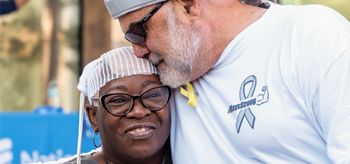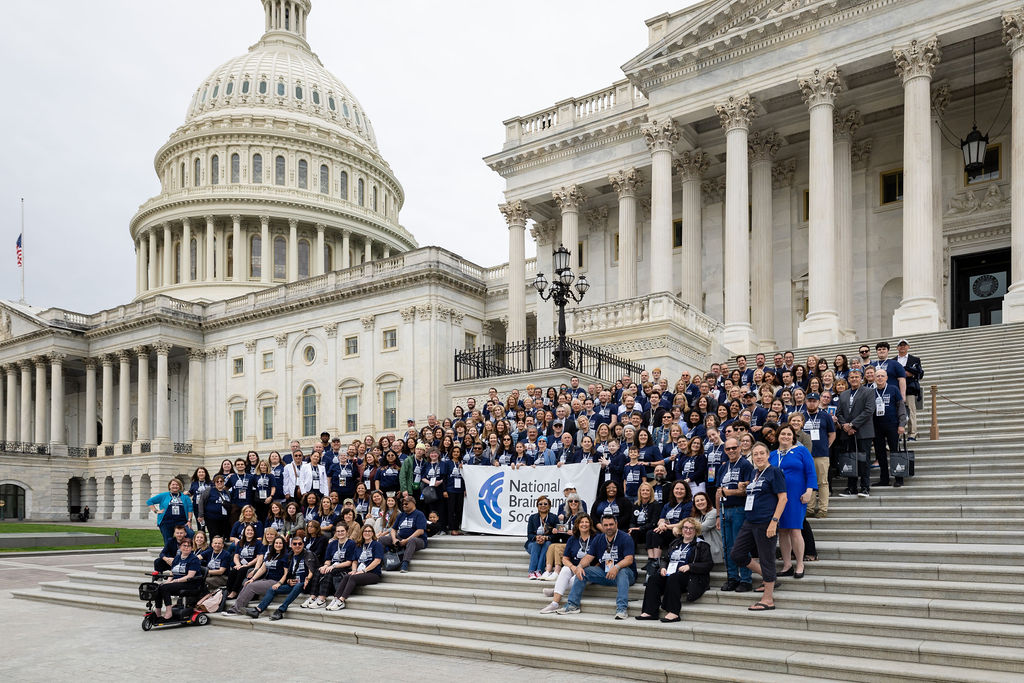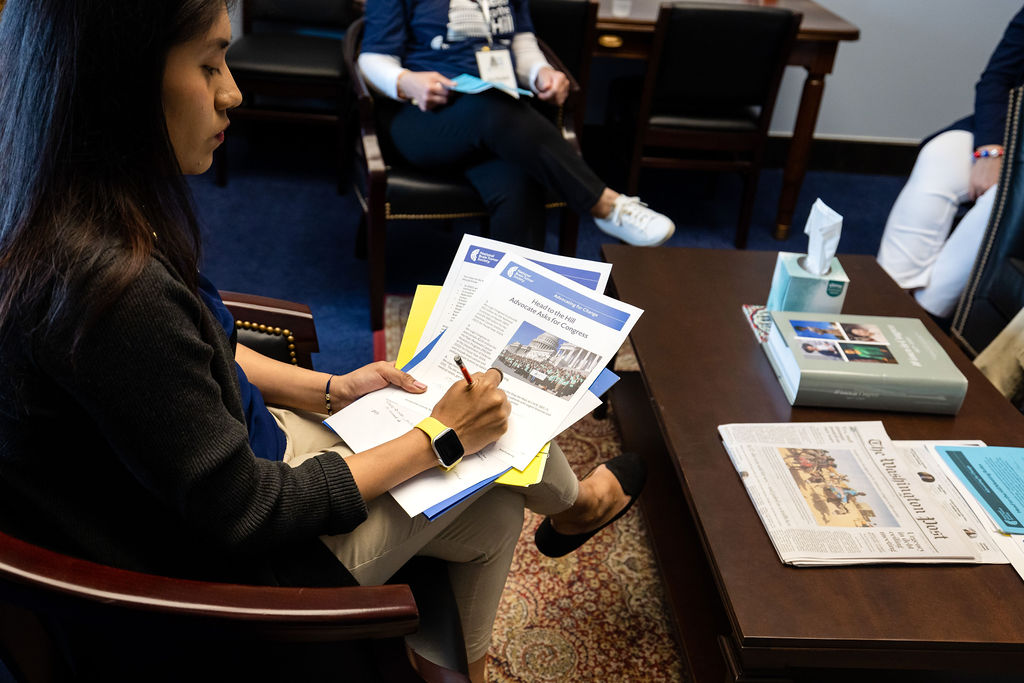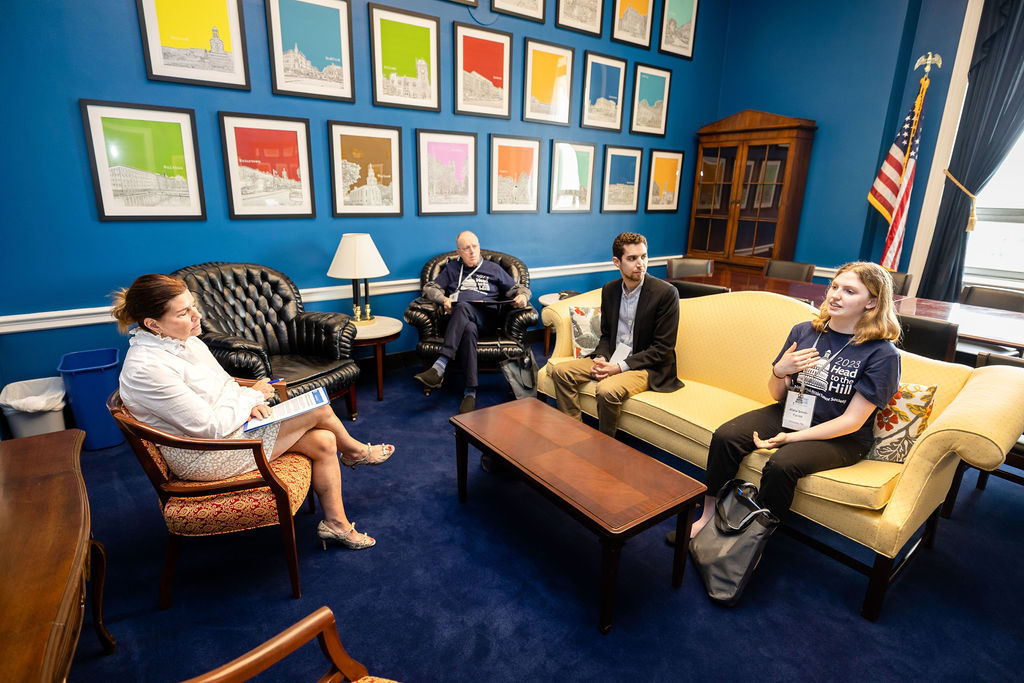National Brain Tumor Society’s volunteer advocacy efforts engage and mobilize approximately 20,000 people across the U.S. to advance public policies that affect brain tumor related research and the specialized health care needs for the one million patients and families living with a brain tumor diagnosis. Our voices are a powerful force for progress and change when we come together.
Many patients with brain tumors, caregivers, and their loved ones may feel uncertain about what exactly advocacy is or unsure of where to start. Explore answers to frequently asked questions about advocacy below.
What is advocacy (for public policy)?
Public policy-related advocacy refers to the act of supporting or promoting a cause, program, or idea to bring about change, usually through creating new laws, changing existing laws, and implementing them. Through our advocacy initiatives, NBTS influences legislation, regulations, and other policies that affect the brain tumor community. A bipartisan Congress, together with the President, in 1976 codified the permissibility of charitable organizations to lobby (or influence legislation), which is one form of advocacy. We can make positive change by informing policymakers of our community’s urgent, unmet needs.
As the largest patient advocacy organization in the U.S. committed to curing brain tumors and improving the lives of patients with brain tumors and their families, NBTS ensures the brain tumor community’s priorities are reflected in national medical research and health care policy through our Public Policy Agenda.
How does advocacy make an impact?
Advocacy for rare diseases like brain tumors can significantly influence policies, increase government funding, strengthen patient protections, improve patient access and adequacy of health care leading to improved health outcomes, and spread awareness. Small actions throughout this process build cumulatively, and the collective efforts of advocates can lead to the passage of meaningful legislation.
About the legislative process: A bill doesn’t happen overnight. It’s a lengthy process where advocates can play a part along the way:
- Lawmakers introduce legislation addressing a particular issue.
- Co-sponsors can sign on both before and after a bill is formally introduced. Co-sponsors are members of Congress who formally express their support for a particular bill by adding their names to the list of sponsors. The number of co-sponsors a bill attracts, especially if it has significant bipartisan support, can increase the chances of the bill being introduced or passed.
- The introduced bill goes through committee review, where committee members assess its merits, potential impact, and feasibility.
- If the bill successfully clears the committee stage, it moves to the floor for debate and voting.
- The bill then must pass both houses of Congress before reaching the president’s desk for approval.
When advocates sign action alerts or contact their members of Congress, it drives attention to a specific issue. Advocate outreach can influence how a policymaker acts, whether it’s signing on as a co-sponsor to a bill, appropriating additional funding, passing awareness resolutions, or voting.
The advocacy of NBTS volunteers has helped lead to important benefits for patients and for brain tumor research:
- Doubling of federal funding for brain tumor research in ten years
- Enactment of laws to strengthen the process of developing new treatments, including the 21st Century Cures, Childhood Cancer STAR Act, and Creating Hope Act
- Support for the NIH’s Neuro-Oncology Branch
- Advancement of legislation aimed to improve access to health care, including the Palliative Care and Hospice Training Act, Accelerating Kids Access to Care Act, and Stop the Wait Act
Why is advocacy important to the brain tumor community?
Public policy decisions that directly and indirectly impact the brain tumor community are made daily. If we do not make our voices heard loud and clear, policymakers will make decisions without considering the needs of individuals affected by brain tumors.
NBTS and its advocates work to:
- Increase research funding and treatment development. We advocate for sustained and meaningful increases in medical research funding. The National Institutes of Health (NIH) is the largest funder of brain tumor research in the world, and private philanthropy cannot replace the level of funding, coordination, and mechanisms needed to advance research that the NIH provides. In addition, the Department of Defense is also a funder of brain tumor research.
- Improve affordability and accessibility of care. We continue to advocate that access to adequate and medically necessary cancer care must keep up with clinical advances and new treatments.
- Foster innovation in brain tumor research, drug development, and access to promising treatments. We advocate for expanded access programs and clinical trial design to ensure that patients with brain tumors have access to the cutting-edge treatments they need while also ensuring that not-yet-approved investigational treatments are adequately evaluated for safety and effectiveness. NBTS also urges policymakers to support medical research innovation.
- Increase awareness of the urgent, unmet needs of the brain tumor community. We work with members of Congress to introduce and pass resolutions for Brain Tumor Awareness Month, DIPG Awareness Day, and Glioblastoma Awareness Day to spread awareness on a national level.
On a personal level, brain tumor advocacy empowers individuals to share their stories, turn adversity into action, and make positive changes on behalf of the greater community.
What does it mean to be an advocate for NBTS?
Advocates play a crucial role in influencing public opinion and policy decisions, ultimately contributing to meaningful change.
Becoming an advocate for NBTS means you’re dedicated to speaking up for yourself and the broader brain tumor community. You’ll be called upon to take action in one way or another, whether signing a petition, emailing your congressional representative, or meeting with them in person.
What are the different ways advocates can support NBTS’s efforts?
Advocacy can take different forms. Here are some examples of how you can get involved as an NBTS advocate:
- Sign virtual action alerts
- Write emails to your members of Congress
- Call your elected representatives
- Participate in Head to the Hill in D.C. in May
- Attend Advocate From Your State virtually in the fall
- Attend in-person events where members of Congress may attend
- Spread the word with people you know, including on social media
- Share your story with NBTS and your network in connection with our advocacy efforts
Why is it essential to keep contacting members of Congress?
We have heard from long-time NBTS advocates wondering why they need to continue emailing their members of Congress about some of the same fundamental issues, like funding for brain tumor research, year after year.
Congress considers thousands of priorities each year, and they compete for time, attention, and resources. Effective advocacy means being persistent and also building and sustaining relationships with members of Congress and their staff. When you share your story and make a connection with them, you enable important relationships to be built.
With rare diseases like brain tumors, much of the country does not understand why the federal government must address specific issues. When advocates contact their elected officials, they remind staff that constituents in their communities need their support on this issue.
Why does my voice matter?
Without a personal story or connection, a policymaker can only consider facts, figures, and costs when evaluating a bill. When advocates share their stories with elected officials, they humanize the issue for them. It only takes one person’s story to resonate with a staff representative or member of Congress and plant a seed.
“Our job is to tell stories on behalf of people and share cold, hard facts about a bill or how we need research funding,” said Kacey Troy Ribnik, NBTS’s Manager of Government Relations and Grassroots Engagement. “What really makes a difference is sharing the real-life consequences of those statistics through personal stories.”
One single email may not seem like a lot, but it does add up when a member of Congress collectively receives a large volume of emails from NBTS advocates in addition to in-person meetings.
“Every policy issue goes through three stages: education, activation, and implementation,” said Sen. Edward Markey, Massachusetts. “Congress is a stimulus-response institution. And there is nothing more stimulating than having hundreds of public health professionals, families, and caregivers meeting with you about an important issue. Advocates have played an integral role in getting politicians to understand public health issues and motivate lawmakers to act. These grassroots efforts have helped us achieve increased funding for health research and surveillance, increased health care coverage, and quick responses to the most important public health threats of our time.”
Additionally, you have your own experience — and perhaps a unique professional background — that can be used to make a difference.
“In our first Head to the Hill, one of the bills we were advocating for was about palliative care and hospice education,” said NBTS advocate Shawn C. “My mom spent her final days in hospice. I shared my mom’s story and directly connected it to the need for this bill in the Capitol Hill meetings, which later passed in the House. It speaks to the power of advocacy and the platform NBTS gives us as a community.”
How can I tell when I’m ready to attend in-person meetings like Head to the Hill as an advocate?
Advocating in person can be emotionally draining, especially for brain tumor advocates grieving the loss of a loved one. Assessing your emotional readiness, personal capacity, and goals is important before participating in an in-person advocacy event.
NBTS aims to create a long-term relationship with each member of Congress because we want them to help advance our priorities. When we meet with an elected official, we want to build positive connections that will lead to change. In meetings with members of Congress, we ask NBTS advocates to stick to addressing our policy priorities and share their stories without anger to ensure we continue to foster these relationships. Emotions can make it harder, so advocates should reflect on whether they’re ready to attend an in-person meeting. NBTS staff is willing and ready to discuss the emotional and intellectual aspects of advocacy and to help you develop your ability to share your story within the framework of public policy.
What quick tips can you share to help get me started?
At a base level, advocacy is building relationships and learning to be persuasive about public policy. The goal is to become a valuable resource for policymakers. No matter who the audience is, you should keep in mind the following:
- Be confident.
- Frame your message to answer the question, “So what?”
- Plan and practice your personal experience with brain tumors and the delivery of your policy message.
- Present a clear and compelling message; less is more.
- Offer yourself as a resource on the experience of living with, caring for, researching, and treating a person with brain tumors (depending upon your background). Provide examples from your own experiences; stories are more compelling than statistics.
How do I become an advocate?
Individuals can register as an NBTS advocate in the five minutes it takes to complete a short interest form. We want you to join us. We need you, and you can make a difference! For those who are already volunteer advocates, we thank you and are grateful that you are a part of the National Brain Tumor Society.
What if I still have questions?
Email our Government Relations & Advocacy team at advocacy@braintumor.org with questions, ideas, and other comments.







